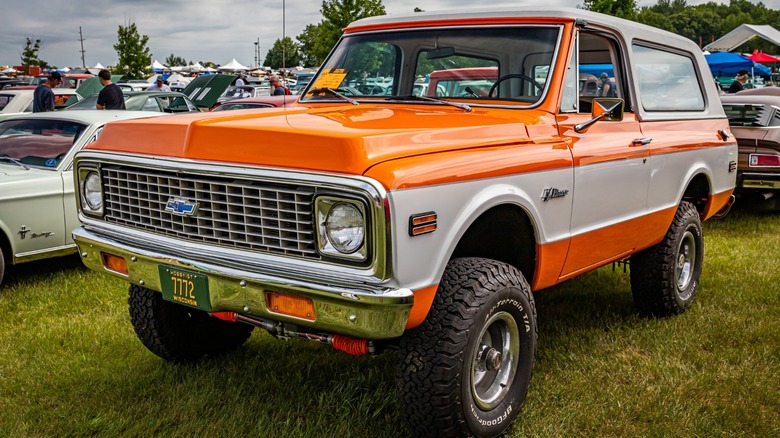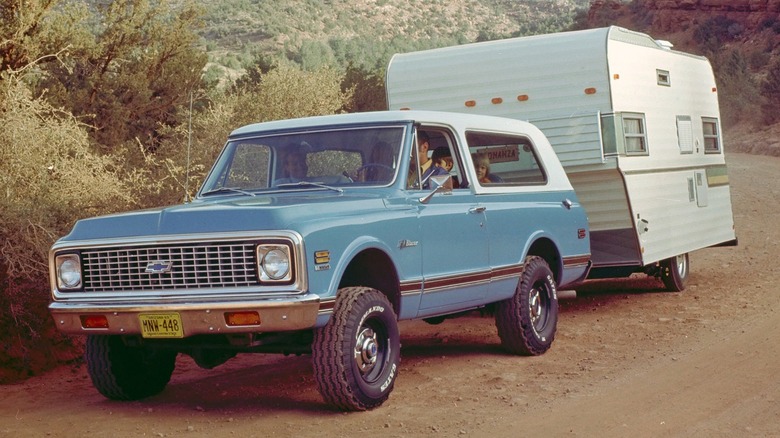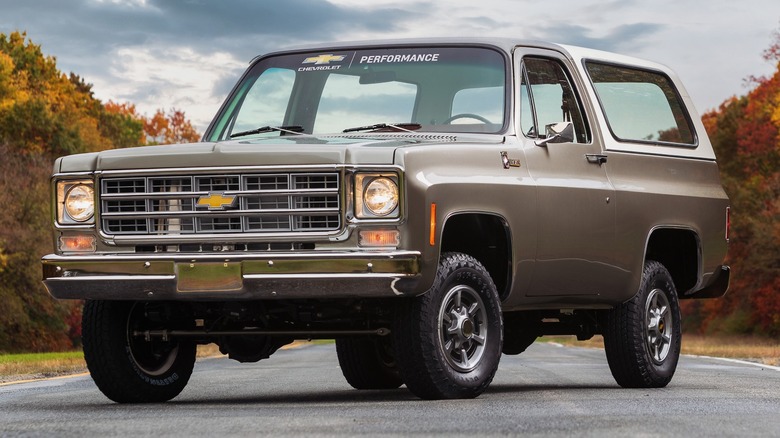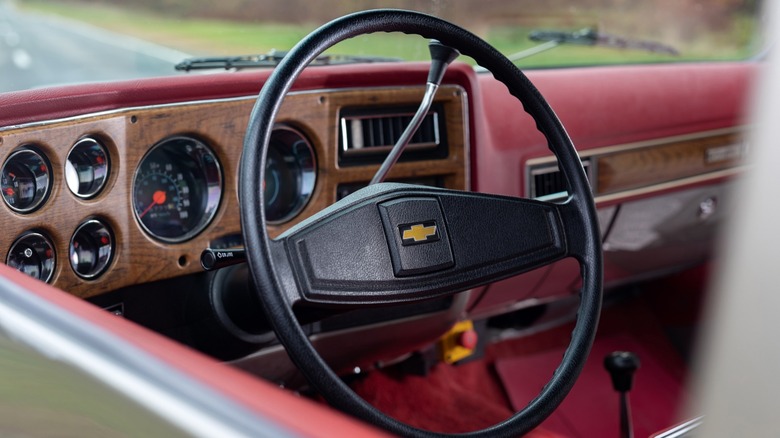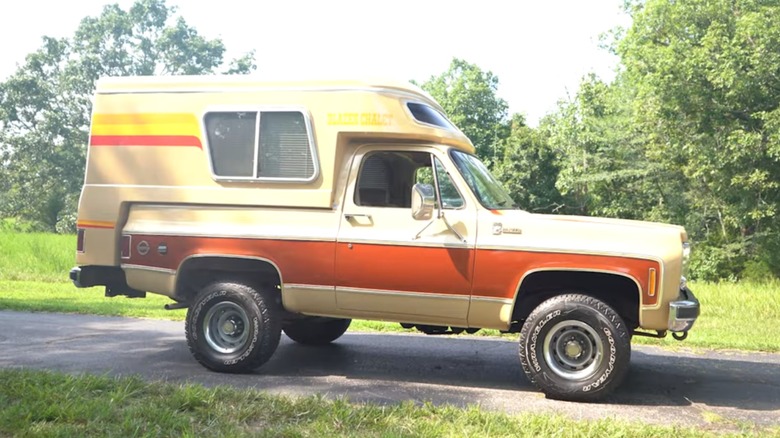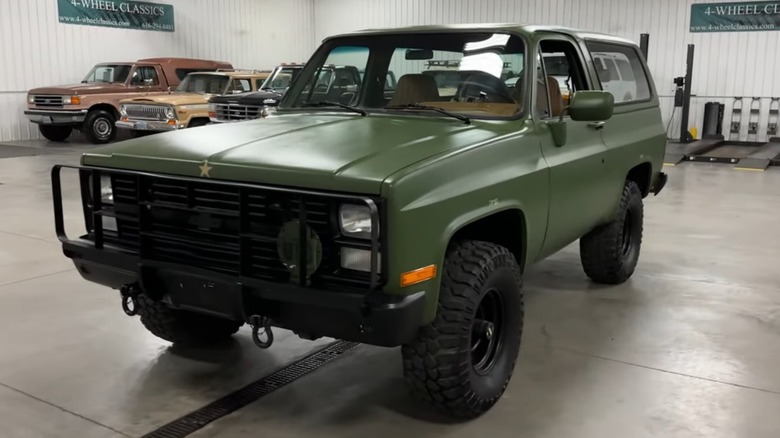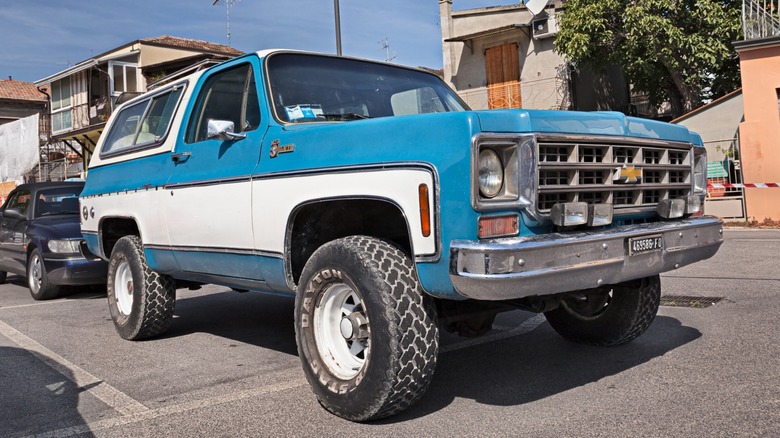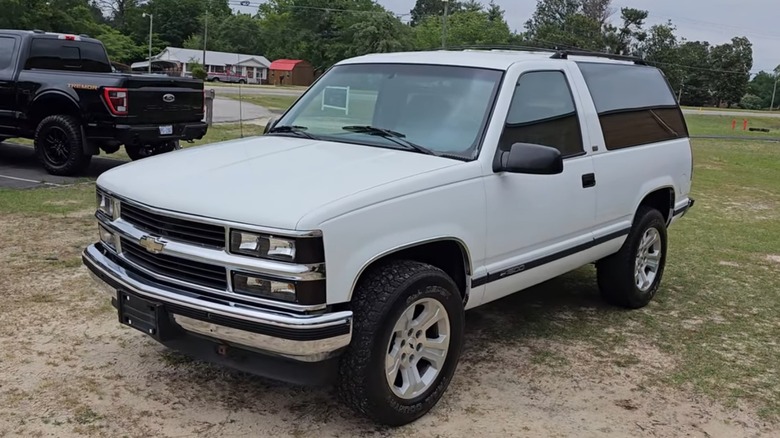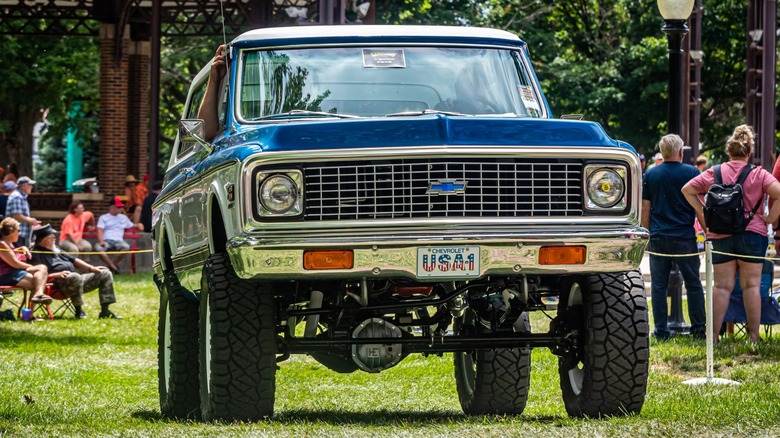8 Of The Coolest And Most Unique Features Of The Original Chevy K5 Blazer
While the SUV either is becoming or is already the dominant type of passenger car on the roads today, depending on where you live, the origins of this style of automobile lie in rugged and spartan all-terrain machines built to the standards of light trucks. The evolution of tough and durable off-roader to luxury family hauler took a couple of decades with incremental changes adding comfort and convenience. And while it was not the first, the Chevrolet K5 Blazer first introduced in 1969 took the lead in setting the stage for the large modern SUV.
Chevrolet manufactured the Blazer from 1969 until 1994 over three generations. While the technology and accessories changed over the years, the basic layout and chassis remained the same throughout. Furthermore, it remained a popular seller, which is why it was never really discontinued — the Blazer name was retired for full-size models and replaced by Tahoe, which has continued until today. The K5 Blazer is a cherished classic, particularly those early first-generation models, and many of them can be found fully restored or highly modified, with an occasional "barn find" popping up on car auction sites. Whether you are a fan of the original first generation, the late "square bodies," or all of them in general, let's have a look at the eight coolest and most unique features of the original Chevrolet K5 Blazer.
Fiberglass top
The first generation of Blazer, produced from 1969 to 1973, debuted with a removable top that extended from the windshield to the rear tailgate. While it might take a friend or two and the removal of a handful of bolts, it was relatively easy to remove, and its fiberglass kept the weight down to something manageable without needing a hoist to lift it. Still, it took a bit of time and effort, so this was not something you wanted to do on a whim, especially if the weather could change in an instant and leave you and your passengers on a soaking-wet ride.
This was altered for the 1974 model year. The fiberglass top remained, but it only covered the rear passenger and cargo area, leaving the front cab intact. This brought with it two benefits. It was easier to seal, as the original was prone to leaks, and it was less unwieldy and easier to store when removed. Plus, those in the front seats could have some respite from the sun when hitting the trails in particularly hot locales and the covered cab provided more rollover safety. A redesign for the 1993 model year came with a fixed roof, which continued through to the Tahoe and remains today.
Full-size chassis
The choice by Chevrolet product designers to build the K5 Blazer on a modified chassis of its existing trucks was clever. Its competition at the time was the Ford Bronco and International Harvester Scout. Both of those vehicles were great off-roaders, but they were smaller than a truck and engineered for the all-terrain experience with only light hauling and city driving in mind. Conversely, the Blazer retained all the capabilities of Chevrolet trucks, only with reduced cargo space.
The genius part of using an existing chassis is the low development costs. Modifying an existing chassis is cheaper by orders of magnitude than creating one from scratch, which had been Chevrolet's original plan that was scrapped over costs. This allowed Chevrolet to keep the Blazer in production with low sales numbers that would kill off any other model. The removable fiberglass top was also a cheap and easy way to make the truck rather than a deliberate feature.
Early on, some automotive journalists were critical of its size, commenting that it was too big to be as competent off-road as the competition. But sentiment changed quickly as trucks got into the hands of the public and people saw how versatile and capable the Blazer really was, leading to a 23-year production run.
All-terrain luxury
Speaking of the first Blazer in terms of luxury is relative. But placed within the context of the era and the offerings of other companies, it comes into clever focus. One of the most well-known off-road vehicles at the time was the Jeep, which probably rings still true today. Considering the Jeep CJ5 on sale back then, nobody would get anywhere close to calling it luxury. That was the most spartan and rugged vehicle you could imagine short of a farm tractor — indeed, after WWII, many farmers used surplus Jeeps for all kinds of agricultural duties. The stiff suspension and short wheelbase made the Jeep great on the trail, and the all-metal interior made it easy to clean after playing in the mud, but none of that made for a comfortable drive.
Stepping into a blazer with its ample room for passengers, full roof over your head, and optional automatic transmission, power steering, and power brakes made it a luxury cruiser in comparison. This made it an attractive option for anyone who needed a vehicle that could tackle rough terrain but also drive to the store in relative comfort, especially since Chevrolet offered a wider array of engine choices than the competition. Also, in 1973, those with the automatic transmission received full-time four-wheel-drive (4WD), eliminating the hassle of getting out to lock the front hubs for 4WD operation, a common feature of off-roaders at the time. The 1969 Blazer created a vehicle segment that did not previously exist. It must have been a good idea, as it eventually led to the development of what are the best-selling vehicles today.
Blazer Chalet
Although Chevrolet only offered it for a couple of years in the late '70s, one of the coolest, or what some might call the best, dealer options turned their vehicle into what was called the Blazer Chalet. Created and produced by Chevrolet with assistance from camper manufacturer Chinook, new Blazer models were built by Chevy and sent to Chinook Mobilodge Inc. for extensive modifications to accept a custom fiberglass camper in place of the rear roof. This was a permanent modification that was available with a long list of options. Furthermore, the Blazer's paint scheme was extended onto the camper, making it look like it was supposed to be there, rather than being a truck bed camper stuck on the back.
Inside the Chalet, you would find a pop-up roof with canvas 360-degree wall extension, dinette/bed combo, storage, and a small kitchen with sink, stove, and small refrigerator. Above the cab is an overhang that can serve as additional storage or a sleeping area for a kid, making it perfect for a small but adventurous family. The camper eliminates the usual space for the spare tire, so it has been relocated to the front bumper, which completes the rugged frontiersman's vehicle look. It's a shame this only lasted for two years with less than 2,000 made because, with the popularity of Overlanding and "van life," it would be a popular option today.
DOD Blazers
GM has been a supplier to the U.S. Military since WWI. Thanks to its factories and workers, this country has equipped countless soldiers with the equipment needed to protect its citizens and defeat its enemies. The military has also used all manner of trucks for innumerable jobs, and, for a time, the K5 Blazer was counted among them. The official Department of Defense designation is M1009 CUCV (Commercial Utility Cargo Vehicle).
Its purpose was to be a cost-effective utility vehicle to be used by the DOD as a sort of stop-gap for troops while the HMMWV was made fully operational and distributed throughout the service branches. The M1009 came powered by a 6.2-liter Detroit Diesel V8 with TH400 transmission and heavy-duty running gear. This makes it officially the only ¾-ton Blazer to come from the factory. Inside everything is bare bones and basic, as is generally expected from military equipment. Camouflage and a stiff brush guard with heavy tow hooks front and rear complete the package. It does have a few military-specific alterations, including a blackout switch that cuts out the headlights on demand. It turns out that they were not practical for military use and performed poorly in the field. They were built from 1983 to 1986 when the program was canceled as the HMMWV program was fully implemented by then.
Interchangeable parts
Because the Blazer chassis comes directly from Chevrolet's light trucks, most parts are interchangeable. Not only did this make them cheaper and easier to develop, but it also, in the context of modern ownership, makes them much easier to repair or restore. Overall, Blazer sales were small compared to Chevy trucks and other vehicles. Over 850,000 were sold over the years while millions of trucks left dealerships. For other cars with a low volume, that can make sourcing parts difficult and possibly costly. But for the Blazer, Chevy truck parts fit just the same in dozens of applications.
This may not be something that had any impact as a new vehicle, but since these have become especially popular and potentially valuable in the modern day, this fact has a huge impact in restoring or modifying one. A barn find Blazer with a bunch of worn-out parts can be fitted with dashboards, seats, engines, windshields, and suspension, just to name a few. The only thing bespoke to the Blazer sits mostly in the rear passenger and cargo area. So if you have inherited an old Blazer from your uncle, don't despair, parts are plentiful.
2WD model
It seems product planners at Chevrolet must have realized that Blazer buyers would not all be buying it for its all-terrain prowess. That is because a two-wheel-drive (2WD) model was offered in its second year of production. It came with independent front suspension and coil springs in the rear, offering a much more comfortable ride with better steering feel than the 4WD model with solid axles and leaf springs on all four corners.
For some buyers, having 4WD is not a priority. The 2WD models were likely bought by people using them for use in the city or as a beach cruiser hauling some surfboards. Information is scarce about these models, but checking parts websites and Automobile-catalog.com only show 4WD models listed after 1982. Even more scarce is information about how many of the total production of the Blazer were 2WD, but it should be safe to say the numbers are low. That makes them rare today, but the scarcity does not necessarily increase value.
Exterior design
The exterior design of the first Blazer came directly from the full-size Chevrolet trucks. This gave it an instant brand identity and made it a part of a family, so to speak. Chevrolet introduced its second generation C/K series of pickups in 1967, meaning the debut Blazer of 1969 would be instantly recognizable to potential buyers. Someone needed something with the capabilities of a truck but with secure covered storage and already liked the Chevrolet pickups were perfect prospects for buyers when it first came out.
History shows that Chevrolet had made the right decision in creating its Blazer as a part of its truck lineup instead of a distinct vehicle. This is evident by its continued production for 23 years and beyond that in the Tahoe successor model. But perhaps more significant is that Ford changed its Bronco in 1978 to an F-100 pickup-based model with a removable top over the rear passenger and cargo area, continuing this style until it was discontinued in 1996. Furthermore, Dodge released a truck-based SUV called Ramcharger in 1974 featuring a removable roof from the windshield back. It lost the removable roof altogether in 1981 and was discontinued after the 1983 model year. This goes to show what a good product the Blazer was for Chevrolet and how a few decisions on creating a product with the lowest possible development costs can sometimes knock one out of the park. That's what Chevrolet did with the K5 Blazer.
